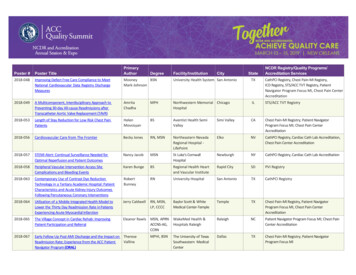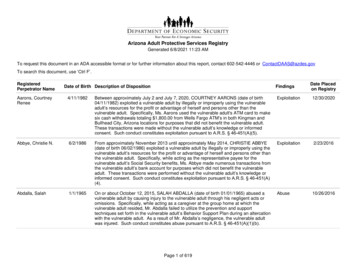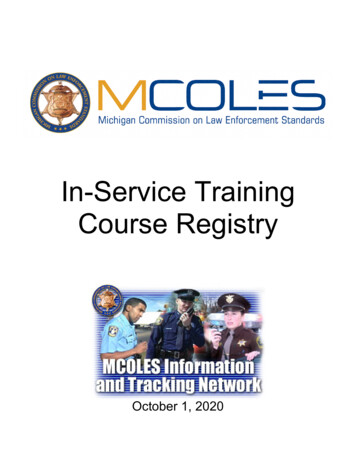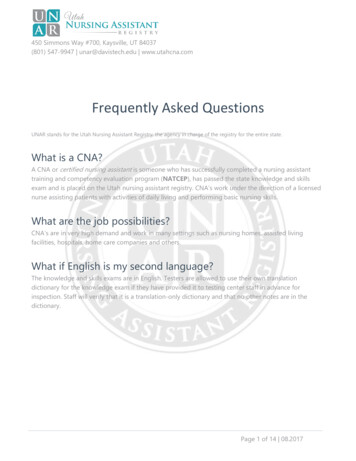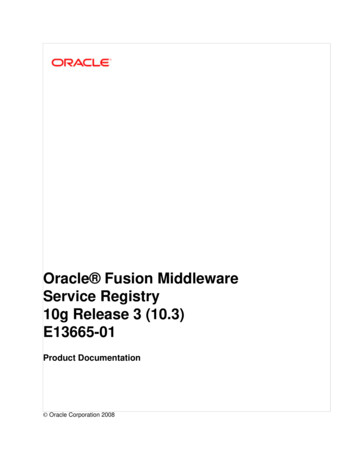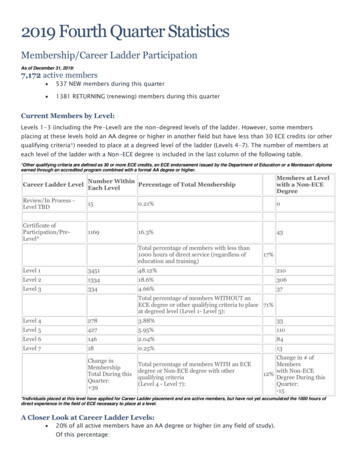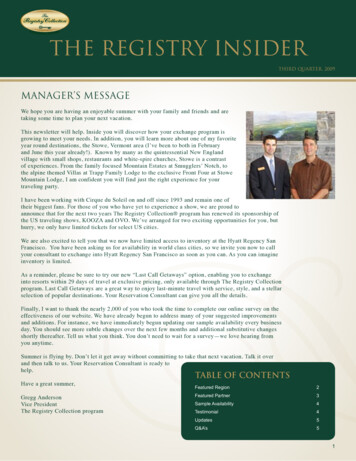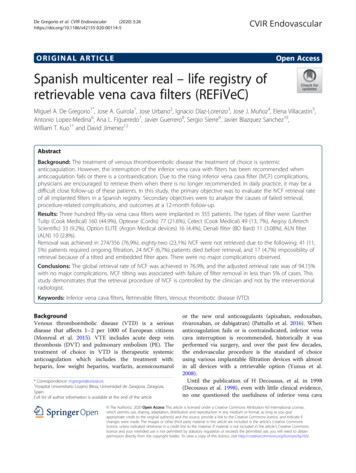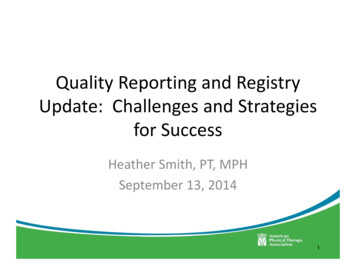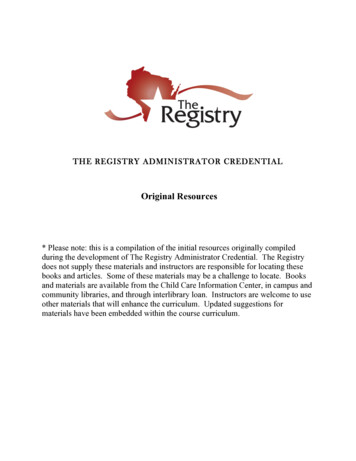
Transcription
THE REGISTRY ADMINISTRATOR CREDENTIALOriginal Resources* Please note: this is a compilation of the initial resources originally compiledduring the development of The Registry Administrator Credential. The Registrydoes not supply these materials and instructors are responsible for locating thesebooks and articles. Some of these materials may be a challenge to locate. Booksand materials are available from the Child Care Information Center, in campus andcommunity libraries, and through interlibrary loan. Instructors are welcome to useother materials that will enhance the curriculum. Updated suggestions formaterials have been embedded within the course curriculum.
Compiled by Chip Donohue, PhDUWM Credential Programs for Child Care AdministratorsRequired Readings / Readings on eReserve for Online CoursesRequired Readings for Course One – Administration & Supervision in Early ChildhoodProgramsIntroduction to Administration/Supervision in Early Childhood ProgramsRogers, F. (1994, July). That Which is Essential is Invisible to the Eye. Young Children.Bowman, B. (1992, Fall/Winter). Self-Reflection as an Element of Professionalism. Erikson.Quality in Early Care and EducationBrener, M. L. (1999). My Morning with Margaret. Young Children, 54(4), 8.Cartwright, S. (1999). What Makes Good Early Childhood Teachers? Young Children,54(4), 8.The Administrator is the Key to Quality: Competencies, Roles & ResponsibilitiesThe In-Basket Task (Gwen Morgan, Wheelock College)Neugebauer, R. (1995, January). The Well Director. Child Care Information Exchange, pp. 30-34.Management and Leadership: Issues of Style & EffectivenessBloom, P. J., & Sheerer, M., & Britz, J. (1991, September/October). Leadership Style AssessmentTool. Child Care Information Exchange, pp. 12-15.Morgan, H. M. (2001, January). A Director’s Lot is not a Happy One. Child Care InformationExchange, pp. 8.The Role of Policy in Program QualityWorking with Staff to Achieve Quality: Issues in Personnel ManagementTom’s Case (Advanced Seminars in Child Care Administration. The Child Care Organization: TheHuman Side of Management – from Gwen Morgan, Wheelock College)Working with Parents: Building Relationships & Promoting PartnershipsThe University Child Development Center (from Gwen Morgan, Wheelock College)Dodge, D. T. (1995, January/February). Sharing your Program with Families. Child CareInformation Exchange, pp. 7-11.Rafanello, D. (1999, September/October). Company’s Coming. Child Care Information Exchange,pp. 9-11.Duff, R. E., Tompkins, M., & McClellan, S. (1995, September/October). Parent Feedback: ACritical Element of Program Quality. Child Care Information Exchange, pp. 25-29.Working with Parents: Moving from Child-Centered to Family-Centered Care
Copeland, M. L. & McCreedy, B. S. (1997). Creating Family-Friendly Policies. Child CareInformation Exchange, pp. 7-12.Greenman, J. (1993, March/April). Places for Childhoods Include Parents, too. Child CareInformation Exchange, pp. 11-14.A Career in Child Care: Next Steps in Your Professional DevelopmentBloom, P. J. (1999, May/June). Learning the ropes. Child Care Information Exchange, pp. 92-93.Riepe, L. (1996, March/April). When You are the New Director – Finding your Way With Staff.Child Care Information Exchange, pp. 11-14.
Compiled by Chip Donohue, PhDUWM Credential Programs for Child Care AdministratorsRequired Readings / Readings on eReserve for Online CoursesRequired Readings for Course 2 – Operations Management in Early Childhood ProgramsWhat Are Systems?What Is Systems Thinking?The Director as a Key to QualityThe Well Director28 Fun Ideas to Motivate Your StaffNeed a Barometer for Assessing the Climate of Your Center?Looking at the Quality of Early Childhood ProgramsMaking Classrooms Work for Children and AdultsEarly Childhood Safety Checklist #5What's Going On Out Here? An Evaluation Tool for Your PlaygroundUsing Your Senses to Adapt Environments: Checklist for an Accessible EnvironmentEvaluating the Child Care Center DirectorEvaluating the Child Care Director: The Collaborative Professional Assessment Process
Compiled by Chip Donohue, PhDUWM Credential Programs for Child Care AdministratorsRequired Readings / Readings on eReserve for Online CoursesRequired Readings for Course 3 – Financial Management and Planning in Early ChildhoodProgramsChild Care Administrative SoftwareTo Profit or Not to Profit: That is the Tough QuestionCenter Size and Center Performance. Do Smaller Centers Deliver Highest Quality?State-of-the-Art Thinking on Parent Fee PoliciesIs your Salary Schedule up to Speed?Guidelines for Fine Tuning your Salary ScheduleThe Fair Labor Standards Act and the Child Care IndustryNine Steps to Headache-Free Fee CollectionPreparing and Using Monthly Financial ReportsHow to Perform Cash Flow AnalysisManaging Money As If Your Center Depended Upon ItCompete or Die! Part ICompete or Die! Part II
Compiled by Chip Donohue, PhDUWM Credential Programs for Child Care AdministratorsRequired Readings / Readings on eReserve for Online CoursesRequired Readings for Course 4 – Early Childhood Programs and the External EnvironmentFocus on Strategic Planning and CollaborationStrategic Management: A Stakeholder ApproachHow to Develop a Strategic PlanMarketing Jack and JillFocus on Quality, Compensation and the TrilemmaLicensing and Accreditation: How Much Quality is Quality?Focus on Marketing Your Program and ServicesThe Center Will Sell Itself.and Other Child Care Marketing MythsMarketing When Your Creativity is High and Your Budget is LowSave the Best Till Last: Retaining Enrollment Through Exceptional Customer ServiceFocus on Grantseeking, Grantwriting and FundraisingGrant Writing Mini-WorkshopGetting Grant Money: How to ConnectProposal Checklist and Evaluation FormWhere Proposals FailWhen Opportunity Knocks, Will You Be PreparedFocus on Family and Community Contexts / Child Abuse Prevention IssuesChild Abuse Prevention Issues for Child Care ProfessionalsPrevention Programs for Child Sexual Abuse: Cause for Concern?Focus on Research, Public Policy and AdvocacyPolicy and Policy Making for Infants, Toddlers, and Their Families: A Primer for PractitionersAdvocacy for Children and Families: It’s All About Relationships
Compiled by Chip Donohue, PhDUWM Credential Programs for Child Care AdministratorsRequired Readings / Readings on eReserve for Online CoursesRequired Readings for Course 5 – Best Practices in Early Childhood ProgramsBest Practices Defining Quality and Identifying “Best Practices”Katz, L. Multiple Perspectives on the Quality of Early Childhood Programs. ERIC Digest, EDOPS-93-2.Best Practices Supporting Healthy Child DevelopmentPlattner, I. E. (2003, July/August). Granting Children their Emotions. Child Care InformationExchange, pp. 34-36Katz, L. (1993, September). Dispositions as Educational Goals. ERIC Digest, EDO-PS-93-10.Minnesota Association for the Education of Young Children. (n.d.). Developmentally AppropriateGuidance of Young Children. MNAEYC.Flicker, E. S. & Hoffman, J. A. (2002, September). Developmental Discipline in the EarlyChildhood Classroom. Young Children, 82-89.Gartrell, D. (2001, November). Replacing Time-Out: Part One – Using Guidance to Build anEncouraging Classroom. Young Children, 8-16.Best Practices Focusing on the FamilyMcBride, S. L. (1999, May). Family-Centered Practices. Young Children, 54(3), 62-68.Work Family Directions. (1996). How Family Friendly is your Center? Center Observation form.Boston, MA: Work Family Directions.Best Practices Honoring DiversityMarshall, H. H. (2001, November). Cultural Influences on the Development of Self-Concept:Updating our Thinking. Young Children, 19-25.Clark, L., DeWolf, S., & Clark, C. (1992, July). Teaching Teachers to Avoid Having CulturallyAssaultive Classrooms. Young Children, 47(5), 4-9.Best Practices Welcoming ALL ChildrenChild Care Information Exchange. (1993, September/October). Beginnings Workshop: Caring forChildren with Differing Abilities. Child Care Information Exchange, pp. 39-58.
Best Practices Creating Empowering Places & SpacesGreenman, J. (1992, July). Places for Childhoods. Child Care Information Exchange, pp. 21-23.Katz, L. G. (1992, March). Looking at the Quality of Early Childhood Programs. Child CareInformation Exchange, pp. 17-18.Prescott, E. (1994, November). The Physical Environment – A Powerful Regulator of Experience.Child Care Information Exchange, pp. 9-15.Olds, A. R. (1994, May). From Cartwheels to Caterpillars: Children’s Need to Move Indoors andOut. Child Care Information Exchange, pp. 32-36.Best Practices Understanding and Implementing ResearchNAEYC. (1997). Brain Development Research – What it Means for Young Children and Families.Early Years Are Learning Years Release #97/11. Washington, DC: NAEYC.Best Practices Providing Training & Professional DevelopmentAlexander, N. P. (1999, November). Understanding Adults as Learners: Guidelines for ProvidingEffective Training Opportunities. Child Care Information Exchange, pp. 82-84Miller, K. (2002, January). Motivating Adults to Learn. Child Care Information Exchange, pp. 7679.Bloom, P. J. (1992, November/December). Looking Inside: Helping Teachers Assess their Beliefsand Values. Child Care Information Exchange, pp. 11-13.Stephens, K. (1994, January). Bringing Light to the Darkness: A Tribute to Teachers. YoungChildren, 49(2), 44-46.Barden, M. (1995, September). Vision: A Critical Characteristic of Effective Child CareAdministrators. Child Care Information Exchange, 78-81.
Compiled by Chip Donohue, PhDUWM Credential Programs for Child Care AdministratorsRequired Readings / Readings on eReserve for Online CoursesRequired Readings for Course 6 – Leadership in Early Childhood ProgramsThe Whole Administrator: Reflective Practice for LeadersDuff, Brown & Van Scoy (1995, May). Reflection & Self-evaluation: Keys to ProfessionalDevelopment.Gratz & Boulton (1996, July). Erikson and Early Childhood Education: Looking at Ourselves andour Profession Developmentally.Leadership: The Administrator's Impact on QualityNeugebauer & Neugebauer (1998). The Paradoxes of Leadership.Leadership Style, Shared Decision Making and Setting the VisionBroussard (1992, January). Are you a Codependent Director?Kurtz (1991, January/February). Stabilizer, Catalyst, Troubleshooter, or Visionary – Whichare you?Powers (1996, May). Cohesive Teaching Teams - What Makes the Difference.The Change Process: The Administrator as Change AgentSchiller (2000). A Director’s Game Plan.Zeece (1996). Power Lines.
Instructor ResourcesThe following is a list of resources for instructors. The Registry does not supply these materialsand instructors are responsible for locating these books and articles.Books and materials are available from the Child Care Information Center, in campus andcommunity libraries, and through interlibrary loan.Resource assistance is available from:The Registry (608) 222-1123Email: registry@the-registry.orgWeb site: www.the-registry.orgAdams, D. (1996). Nuts and Bolts of Child care and Early Childhood Program Administration.Madison, WI: Madison Education Extension Programs University of Wisconsin-MadisonAllison, G. (1971) Essence of Decision: Explaining the Cuban Missile Crisis. Boston: LittleBrown.Almy, M. (1975). The Early Childhood Educator at Work, New York: McGraw-Hill.Almy, M. (1988). The Early Childhood Educator Revisited, In B. Spodek, 0. N. Saracho, & D. L.Peters (Eds.), Professionalism and the Early Childhood Practitioner. New York: TeachersCollege Press.Anthony, M. A. (1998, September/October). Stages of Director Development. Child CareInformation Exchange, page 81-83.Austin, A., & Morrow, S. (1985). Concerns of Child Care Administrators as Modified byEducation, Experience, and Ownership of Facility, Educational Research Quarterly, pages 10(2), 25-30.Axelrod, R, & Buch, E. R. (1974). Preschool and Child Care Administration, Ann Arbor:University of Michigan, Program in Early Childhood Education.Baden, R., Genser, A., Levine, J. & Seligson, M. School-age Child Care: An Action Manual.Bellm, D. & Whitebook, M . A Good Sub is Hard To Find: Recruiting and RetainingTemporary Staff for Child Care Programs. Washington D.C.: Center for Child CareWorkforce.Bellm, D. & Whitebook, M. (1993). Salary Surveys: How? Why? When? How to Conduct One inYour Community. Washington, D.C.: Center for Child Care WorkforceBellm, D. & Whitebook, M. (1986) Model Workforce Standards, Washington D.C.: Center for Child CareWorkforce.Bellm, D. & Whitebook, M. (1999) Taking on Turnover: A Workbook for Directors and Teachers.Washington D.C.: Center for the Child Care Workforce.Bertalanffy, L.V. (1968) General System Theory, New York: George Braziller.Bloom, P. J., Sheerer, M. & Britz, J. (1991), Blueprint for Action, Mt. Ranier, MD. Gryphon House.Bloom, P. J. (1988). A Great Place to Work. Improving Conditions for Staff in Young Children'sPrograms. Washington, DC: National Association for the Education of Young Children.Bloom, P. J. (1988). Factors Influencing Overall Job Commitment and Facet Satisfaction inEarly Childhood Work Environments. Journal of Research in Childhood Education, 3 (2), 107122.Bloom, P. J. (1989). Professional Orientation: Individual and Organizational Perspectives.Child and Youth Care Quarterly, 18 (4), 227-240.Bloom, P. J. (1990). The Child Care Center Director: Policy Perspectives on IncreasingRequisite Qualifications. Early Education and Development, 1(3), 185-204.
Bloom, P. J. (1992, Spring). The Child Care Center Director: A Critical Component of ProgramQuality. Educational Horizons.Bloom, P. J. (1999, May/June). Learning the Ropes. Child Care Information Exchange, 92-93.Bloom, P. J., & Rafanallo, D. (1995, Winter). The Professional Development of Early ChildhoodCenter Directors: Key Elements of Effective Training Models. Journal of Early ChildhoodTeacher Education.Bowman, B. (1992, Fall/Winter). Self-Reflection as an Element of Professionalism. Erikson.Bredekamp, S., & Copple, C. (Eds.). (1997). Developmentally Appropriate Practice in EarlyChildhood Programs (Rev, ed.). Washington, DC: National Association for the Education ofYoung Children.Bredekamp, S. & Willer, B. (Eds.), (1996). NAEYC Accreditation: A Decade of Learning & theYears Ahead. Washington, DC: National Association for the Education of Young Children.Bredekamp, S., & Willer B. (1993, March). Professionalizing the Field of Early ChildhoodEducation: Pros and Cons. Young Children.Bredekamp, S. and B.A. Willer (Eds.), NAEYC Accreditation: A Decade of Learning & the YearsAhead (pp 129-138).Bredekamp, S. & Copple, S. (editors) (1997) Developmentally Appropriate Practices.Washington, D.C.: National Association for the Education of Young Children.Brown, J. E. (Ed.). (1986). Administering Programs for Young Children. Washington, DC:National Association for the Education of Young Children.Broussard, a. (1992, January). Are you a Codependent Director? Child Care InformationExchange, pp. 7-11.Bruner, J. (1996). The Culture of Education. Cambridge, MA: Harvard University PressCaesar, B. (1999, September/October). Playground Safety for the 21st Century. Child CareInformation Exchange, pp. 88-93.Caplow T. (1983) Managing an Organization (2nd ed.). NY: Holt, Rinehart & Watson.Carter, M. & Currie, M. (1996). Spreading the News. National Association for the Education ofYoung Children.Carter, M. (1993, March/April). Assessing Environments for Anti-bias and Culturally RelevantMaterials. Child Care Information Exchange, p. 55.Carter, M., & Curtis, D. (1998). The Visionary Director: A Handbook for Dreaming, Organizing,& Improvising in Your Center. St. Paul, MN: Redleaf Press.Caruso, J. J., & Fawcet, M. T. (1986). Supervision in Early Childhood Education: ADevelopmental Perspective. New York: Teachers College Press.Cherry, C. (1995, September). Just What Does a Director Really Do? Child Care InformationExchange, 17-21.Cherry, C., Harkness B., & Kuzma, K. (1987). Nursery School & Day Care Management Guide(2nd Ed.). Fearon Teacher Aids.Child Care Information Exchange. (1995). 250 Management Success Stories from Child CareCenter Directors. Redmond, WA: Child Care Information Exchange.Chugani, H.T. ( 1997). Neuroimaging of Developmental Non-Linearities & DevelopmentalPathologies. In R.W. Thatcher, G.R. Lyon, J. Rumsey & N. Krasnegor (Eds.),Developmental Neuroimaging: Mapping the Development of Brain & Behavior. (pp. 187195). San Diego: Academic Press.Click, R, & Click, D. W. (1995). Administration of Schools for Young Children (4th ed.).Albany, NY-. Delmar.Collins, J.E. & Porras, J.I. (1994). Built to last: Successful habits of visionary companies. NY:Harper Business.Community Coordinated Child Care. (1986). Nuts and Bolts Handbook: Building Good DayCare in Wisconsin. Madison, WI: Community Coordinated Child Care.
Community Coordinated Child Care. (1985). A Handbook for the Day Care Board of Directors.Madison, WI: Community Coordinated Child Care.Copple, C. (1990). Quality Matters: Improving the Professional Development of the EarlyChildhood Workforce. Washington, DC: National Institute for Early Childhood ProfessionalDevelopment.Cost, Quality & Child Outcomes Team (1995). Cost, Quality & Child Outcomes in Child CareCenters. Denver, CO: Center for Research in Economics & Social Policy, Department ofEconomics, University of Colorado.Cromwell, E. S. (1994). Quality Child Care: A Comprehensive Guide for Administrators andTeachers. Boston: Allyn & Bacon.Culkin, M (1994) The Administrator/Leader in Early Care and Education Settings: A QualitativeStudy with Implications for Theory and Practice. Unpublished doctoral dissertation, The UnionInstitute, Cincinnati, OH. (UMI Abstracts International, No. 9502053)Culkin, M. (1995). Literature Review About Early Care and Education (ECE) Administrators asLeaders/Managers. Prepared for the Symposium on Director Credentialing. Boston, MA:Work/Family Directions.Damasio, A. (1994). Descartes’ Error: Emotion, Reason, & the Human Brain. NY:Grosset/Putnam.Day Care Council of America. (1981). How to Start a Day Care Center. Washington, DC: U.S.Department of Health and Human Services. Office of Human Development ServicesAdministration for Children, Youth and Families.Deacon, T.W. (1997). The Symbolic Species: The Co-Evolution of Language & the Brain. NY:WW Norton.Decker, C. A., & Decker, J. R. (1992). Planning and Administering Early Childhood Programs(5th ed.). New York: Merrill.Deming, W.E. (1986). Out of the Crisis. Cambridge, MA: Cambridge University Press.Eccles, J.C. (l989). Evolution of the Brain: Creation of the Self. NY: Routledge.Dodge, D. T. (1995, January/February). Sharing your Program with Families. Child CareInformation Exchange.Dombro, A. L., Colker, L. J., & Dodge, D. T. (1998). A Journal for Using the CreativeCurriculum for Infants and Toddlers. Washington, DC: Teaching Strategies, Inc.Drucker, P. F. (1974). Management: Tasks, Responsibilities, Practices. New York: Harper, RowDrucker, P. (1990). Managing the Nonprofit Organization: Principles & Practices. NY: HarperCollins.Duff, R. E., Brown, M & Van Scoy, I (1995, May) Reflection & Self-Evaluation: Keys toProfessional Development. Young Children, 50(4). Pp.81-88Gardner, H. (1993). Multiple Intelligences: The Theory in Practice. NY: Basic Books.Gratz, R. & Boulton, P. (1996, July). Erikson and Early Childhood Education: Looking atOurselves and Our Profession Developmentally. Young Children, 51(5), pp 74-78.Eccles, J.C. (l989). Evolution of the Brain: Creation of the Self. NY: Routledge.Eiselen, S. (1992 ). The Human Side of Child Care Administration: A How to Manual.Washington D. C.: National Association for the Education of Young ChildrenEvans, E. B., Saia, G., & Evans, E. A. (1974). Designing a Day Care Center: How to Select,Design, and Develop a Day Care Center. Boston: Beacon Press.Feeney, S., & Kipnis, K. (1990). Code of Ethical Conduct & Statement of Commitment:Guidelines for Responsible Behavior in Early Chi
Compiled by Chip Donohue, PhD UWM Credential Programs for Child Care Administrators Required Readings / Readings on eReserve for Online Courses Required Readings for Course 6 – Leadership in Early Childhood Programs The Whole Administrator: Reflective Pra


